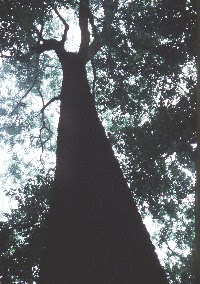I first visited this site in July of 1976, when I was
quantitatively analyzing Connecticut’s newly defined critical habitats. The site had grown up to a dense, even-aged
stand of young trees, most of which could trace their beginning to 1938. During my investigation, the prevailing
forest cover was of trees just under 40 years old and with an average diameter
at breast height (dbh) of 18 cm.
Except- all the old trees had not been blown down. There were still a handful of much bigger
trees that had clearly started growing long before that time. There was a monumental sassafras with a 62.3
cm dbh - two feet across- quite something for a tree that typically appears in
southern New England forests as a scrawny understory tree. There was also a
mammoth white oak with a dbh of 86.6 cm- approaching three feet in diameter- a
black oak of 53.3 cm dbh, a red maple of 72.9 cm dbh and a ‘red’ pignut hickory
of 72.9 cm dbh.
To characterize this site and to provide a baseline for
future investigation, I established a 10 x 20 m plot that was clearly delineated
by the presence of a massive boulder at its northeast corner (remember, these
were the days before GPS). I found 11
canopy trees of three species that had a mean diameter of 25.9 cm. The giant sassafras was the largest of
them. Saplings included the same
species found in the canopy: white oak, black oak and sassafras, although it
appeared that red maple might grow in importance as a canopy tree. The site was
also a very xeric one, with a shrub layer dominated by a dense stand of
huckleberry.
This brings us to today- 28 July 2016- when I again visited
the site and re-surveyed my old plot, still easily distinguishable from the
presence of the boulder and immense sassafras. Over the intervening 40 years, the forest had changed, with only
seven canopy trees now averaging 37.4 cm dbh being present. One of these was indeed a red maple of 18.1
cm dbh- a 1976 understory tree that had, as predicted, invaded the canopy. Furthermore, the old sassafras, although
still an imposing presence within the plot, was recently dead, with its
uppermost branches now carpeting the forest floor. The shrub layer was still strongly dominated by huckleberry,
although the tall blueberry I had identified in the plot turned out to be Vaccinium
atrococcum rather than the V. corymbosum I had mistaken it for in
1976- silly me; the latter is a wetland shrub, as I knew, and this was no
wetland. The former is much more of an upland species in southern New England.
In general, the canopy of the site as a whole had greatly
thinned and now resembled that of typical mature forests in the region. Indeed, with a present prevailing canopy age
of about 80 years, it should . As I
investigated the vicinity, I found a number of substantial tree specimens. I measured 22, which had an average dbh of
62.2 cm compared with 49.9 cm dbh for 24 trees in 1976. The largest was now an 83.9 cm dbh red
maple.
I have now lived long enough to witness first hand the
process of forest succession- not inferred it from forest stands of different
ages, but directly observed it by examining the same plot over a very long series
of years. This raises an issue: this
site, with its long and periodically catastrophic history, does indeed
represent a virgin stand despite not looking terribly different than a hundred
others in the vicinity.
Periodic disruption is part of the natural process that keeps this woodland in a state of more or less dynamic equilibrium. Fortunately for those of us interested in such things, it is now
owned by a land trust, so we can continue to follow its evolution for decades
to come.
Robert J. Craig
Robert J. Craig


